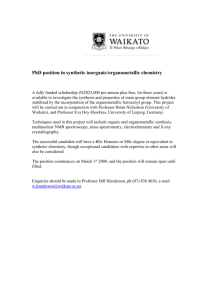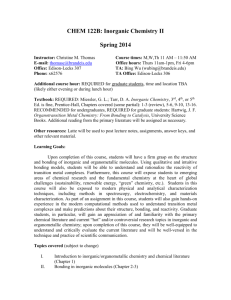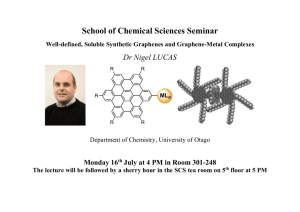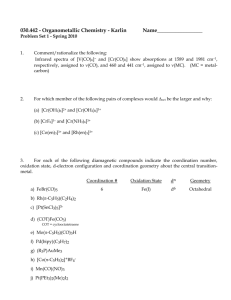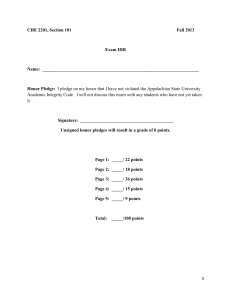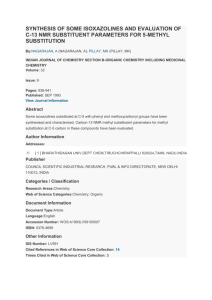B19IC - Organometallic Chem and Multi NMR Spectroscopy
advertisement
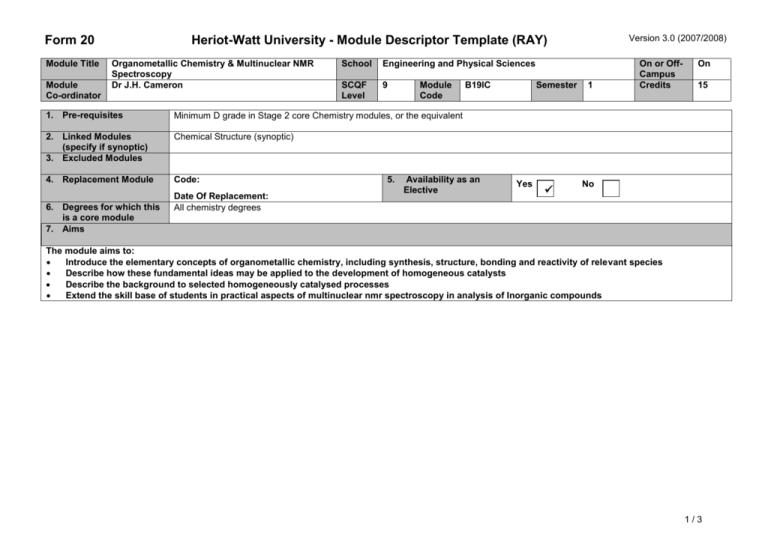
Form 20 Module Title Module Co-ordinator Version 3.0 (2007/2008) Heriot-Watt University - Module Descriptor Template (RAY) Organometallic Chemistry & Multinuclear NMR Spectroscopy Dr J.H. Cameron School Engineering and Physical Sciences SCQF Level 9 Module Code 1. Pre-requisites Minimum D grade in Stage 2 core Chemistry modules, or the equivalent 2. Linked Modules (specify if synoptic) 3. Excluded Modules Chemical Structure (synoptic) 4. Replacement Module Code: 6. Degrees for which this is a core module 7. Aims Date Of Replacement: All chemistry degrees 5. B19IC Availability as an Elective Semester Yes 1 On or OffCampus Credits On 15 No The module aims to: Introduce the elementary concepts of organometallic chemistry, including synthesis, structure, bonding and reactivity of relevant species Describe how these fundamental ideas may be applied to the development of homogeneous catalysts Describe the background to selected homogeneously catalysed processes Extend the skill base of students in practical aspects of multinuclear nmr spectroscopy in analysis of Inorganic compounds 1/3 Form 20 Module Title Module Co-ordinator Version 3.0 (2007/2008) Heriot-Watt University - Module Descriptor Template (RAY) Organometallic Chemistry & Multinuclear NMR Spectroscopy Dr J.H. Cameron School Engineering and Physical Sciences SCQF Level 9 Module Code B19IC Semester 1 On or OffCampus Credits On 15 8. Syllabus Ligand classification; X/L notation, electron counting; Common Organometallic Ligands; 18e- Rule - rationalisation, scope and limitations Carbonyl Complexes and Related Species: Transition metals carbonyls: Synthesis, structure and bonding, reactivity; Phosphine ligands: Bonding, electronic and steric effects Alkyl Complexes and Related Species: Transition metal alkyls: Stability, synthesis and reactivity. Related species: Transition metal aryls, acyls and alkenyls. Transition metal alkylidenes and alkylidynes - synthesis Complexes with -Ligands: Transition metal alkene and alkyne complexes: Structures and bonding, synthesis and reactivity. Bonding in C 3 to C6 -ligands. Cyclopentadieneyl and Arene Complexes: Cp complexes: Structures, synthesis and reactivity. -Arene complexes: Structures, synthesis and reactivity. Practical considerations: Experimental techniques and characterisation. Fundamental Organometallic Reactions: - Ligand Substitution; Oxidative Addition/Reductive Elimination; Migration/Transfer Reactions; Reactions of Coordinated Ligands Catalytic Processes: Homogeneous Catalysis: A selection of the following topics will be covered: Hydrogenation; Hydroformylation; Monsanto Acetic Acid Process; Wacker Process; Alkene Polymerisation; Pd-mediated organic synthesis (e.g. Stille, Heck) Practical aspects of NMR spectroscopy Magnetic equivalence and non-equivalence ; spin-lattice and spin-spin relaxation and their consequences for the spectrum Multinuclear NMR spectroscopy as applied to inorganic and organometallic chemistry Applications of 2D NMR techniques in structure solution 9. Learning Outcomes (HWU Core Skills: Employability and Professional Career Readiness) Subject Mastery Understanding, Knowledge and Cognitive Skills Scholarship, Enquiry and Research (Research-Informed Learning) On completion of the module, the learner should be able to: classify the range of ligands prevalent in organometallic chemistry and apply this to electron counting rules governing their complexes with the transition metals apply the 18e and 16e counting rules and to understand simple ideas underpinning these rules demonstrate a knowledge of the structures, bonding and reactivity of a range of typical organometallic complexes featuring carbonyl, phosphine, alkyl and linear and cyclic -ligands. demonstrate a knowledge of typical reactions of organometallic complexes demonstrate a knowledge, including the mechanisms, of a range of catalytic homogeneous catalytic processes of importance in industry and synthetic organic chemistry demonstrate a broad and integrated knowledge multinuclear nmr spectroscopy at an appropriate level use a sound background knowledge of nmr spectroscopy to analyse and interpret the spectra of compounds exhibiting a range of spin-spin systems 2/3 Form 20 Module Title Module Co-ordinator Version 3.0 (2007/2008) Heriot-Watt University - Module Descriptor Template (RAY) Organometallic Chemistry & Multinuclear NMR Spectroscopy Dr J.H. Cameron School Engineering and Physical Sciences SCQF Level 9 Module Code B19IC Semester 1 On or OffCampus Credits On 15 Personal Abilities Industrial, Commercial & Professional Practice Autonomy, Accountability & Working with Others Communication, Numeracy & ICT Personal abilities are embedded in the module. The module provides the opportunity to : Demonstrate problem-solving skills and the ability to critically evaluate ideas and information Use and evaluate information from a range of sources Present information using a range of IT applications Manage time effectively, work to deadlines and prioritise workloads Communicate complex ideas and information effectively to a group of peers Use ICT skills with on-line materials, assessments (formative and summative) and web links to support the learning process Apply strategies for appropriate selection of relevant information from a wide source and large body of knowledge Practise the use of standard methods in the solution of routine chemical problems within familiar contexts Exercise some initiative and independence in carrying out defined activities Work with groups of peers to discuss chemical problems and identify solutions 10. Assessment Methods 11. Re-assessment Methods Method Duration of Exam Weighting (%) Synoptic modules? Method Duration of Exam (if applicable) Synoptic Examination Class test Continuous Assessment Laboratory Work 12. Date and Version Date of Proposal 27 August, 2007 3h 2h Date of Approval by School Committee (if applicable) 50% 15% 15% 20% B19ID Synoptic Examination (100%) Date of Implementation 15 September, 2008 3h Version Number 1.0 3/3
